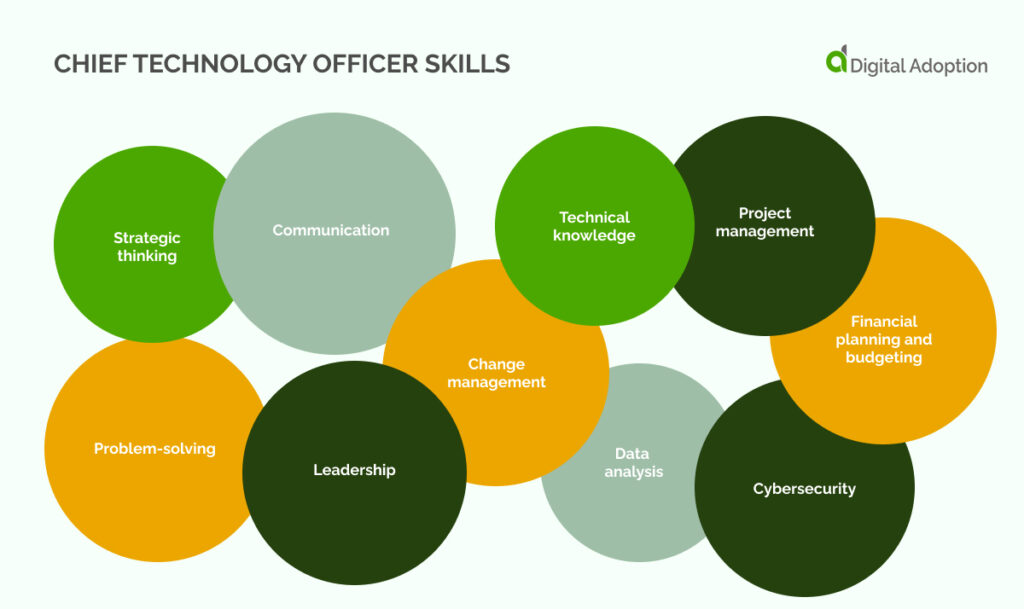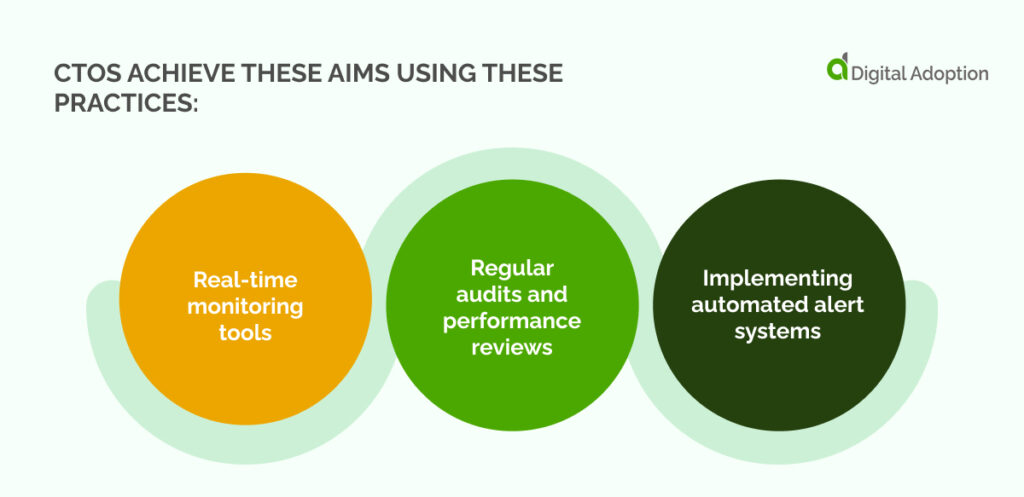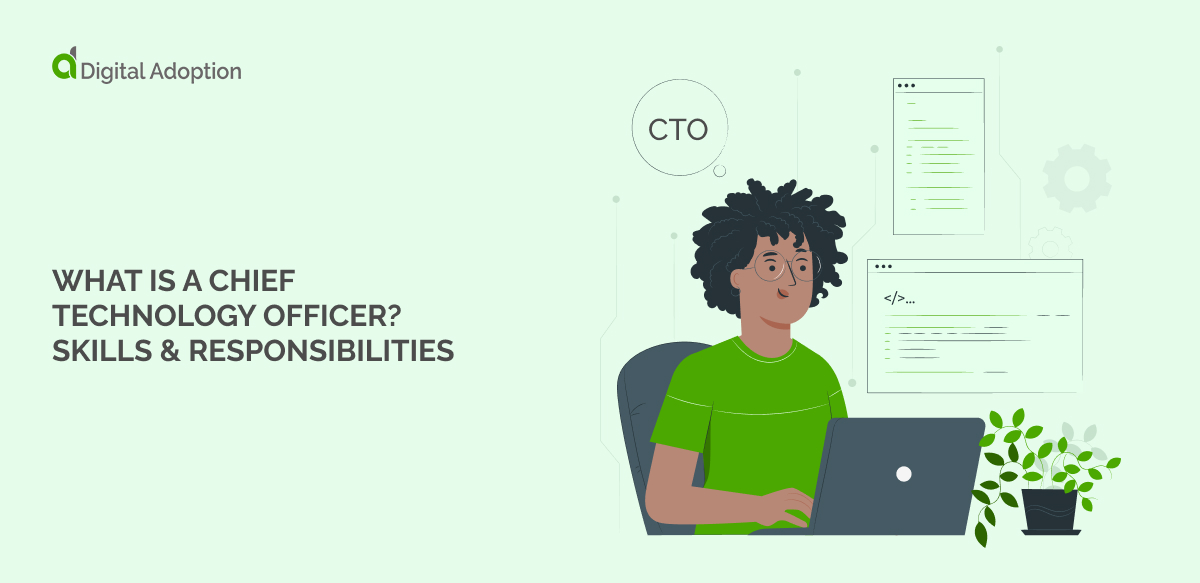With technology at the forefront of enterprise success, you need someone who knows the state of the market and every new solution inside out to drive technology integration and digital adoption.
Technologies like generative AI applications (ChatGPT, Google Gemini) have shifted the perception of how technology can support automation and increase employee productivity. The global market value of generative AI was nearly USD 45 billion in 2023. However, 68% of employees using generative AI tools don’t tell their leaders about it.
The chief technology officer (CTO) can ensure employees receive training to help them understand how to use technology and communicate with their managers to optimize their use of technology and its cost and ensure ROI and success by avoiding rogue IT practices.
The CTO holds other responsibilities, including technology strategies, providing training, managing finances, and resource allocation.
This article defines the CTO, their skills, responsibilities, and who they report to. By the end of this article, you will know what CTOs do, their company position, and how to optimize them in your enterprise.
What is a chief technology officer?
A chief technology officer (CTO) is the executive responsible for an organization’s technology needs and research and development (R&D). Also called a chief technical officer, this individual assesses the organization’s short—and long-term needs and allocates capital for investments aimed at achieving the organization’s goals.
They drive technological innovation, align tech strategy with business goals, and ensure competitive advantage, fueling enterprise success.

Chief technology officer skills
CTOs need more than technical knowledge. They must know larger systems, communicate with other C-suites, and support team members in accepting new technologies. To achieve these goals, they need leadership, communication skills, and technical knowledge for solutions today and tomorrow.
Strategic thinking
A CTO must maintain a clear vision for the company’s technological trajectory. Strategic thinking involves anticipating future technological needs and potential challenges and then
crafting comprehensive plans to address them.
They develop a long-term technology roadmap to anticipate market trends, ensuring the company stays competitive and achieves future growth objectives.
Their foresight helps them set long-term goals and ensure that technology investments align with the company’s overall business strategy, driving sustained growth and innovation.
Communication
Exceptional communication skills are crucial for a CTO. This skill involves translating complex technical concepts into understandable language for stakeholders, team members, and customers.
They translate complex technical details into clear reports for stakeholders, ensuring alignment between technology initiatives and business goals.
Active listening and appreciating diverse perspectives are essential. Effective communication ensures that technical goals align with business objectives and that all parties are informed and engaged in the technology strategy.
Problem-solving
CTOs often face intricate problems that require thoughtful solutions. Strong problem-solving skills involve analyzing complex issues, exploring various solutions, and selecting the most effective action.
They resolve critical system outages by analyzing root causes, implementing fixes, and optimizing processes to prevent future disruptions.
By addressing technical challenges with a strategic approach, CTOs ensure that solutions are both innovative and practical, contributing to the overall success of the organization’s technology initiatives.
Leadership
The CTO’s role extends beyond managing technology, including leading and inspiring a team. Effective leadership involves setting clear objectives, delegating tasks appropriately, and fostering a supportive environment where innovation can flourish.
They lead cross-functional teams in developing innovative products, motivating staff, setting clear goals, and fostering a collaborative work environment.
By motivating team members and creating a culture of collaboration and trust, the CTO ensures that the team can achieve its goals and drive the company’s technology strategy forward.
Change management
Navigating transitions and adapting to technological or process changes is a crucial responsibility for CTOs. Effective change management requires technical expertise and the ability to guide and reassure the team through these transitions.
They oversee smooth transitions to new technologies, guiding teams through the process and addressing resistance to ensure successful implementation.
By managing change proactively, CTOs help maintain morale and ensure that the organization implements new technologies or processes smoothly and successfully.
Technical knowledge
A CTO must possess high technical proficiency in various domains, such as programming, database management, systems analysis, and cloud computing. This expertise is crucial for understanding and effectively applying technology solutions.
They leverage expertise in cloud computing to optimize infrastructure, improving performance and scalability while aligning with organizational needs. They are also experts in building a technology rationalization plan to assess the suitability of new technologies.
Integrating technical knowledge with practical application helps make informed decisions and lead technology projects successfully.
Project management
Project management skills are essential for a CTO to oversee and ensure the successful completion of technology projects. This process includes planning, organizing, and managing resources to meet deadlines and stay within budget.
CTOs manage technology projects by setting timelines, coordinating resources, and ensuring deliverables meet specifications and deadlines within budget.
Effective project management ensures that the organization executes technology initiatives efficiently, meets objectives, and delivers value to the organization.
Financial planning and budgeting
CTOs need a firm grasp of budgeting and financial planning to manage IT expenses effectively. This action involves establishing and overseeing IT budgets, forecasting costs, and ensuring efficient resource usage.
They develop and manage IT budgets, forecasting expenses and allocating resources effectively to support technology investments and operational needs.
Fiscal responsibility helps make strategic investment decisions and maintain financial health while pursuing technology-driven goals.
Data analysis
CTOs must be adept at data analysis to make data-driven decisions. This approach involves interpreting raw data to extract meaningful insights that inform strategic choices.
They use data analytics to identify trends and insights, guide strategic decisions, and enhance operational efficiency across various departments.
Strong data analysis skills enable CTOs to understand trends, forecast needs, and align technology initiatives with business objectives, driving effective and informed decision-making.
Cybersecurity
A CTO must have extensive knowledge of cybersecurity principles and practices in an era of data breaches and cyber threats. Protecting the organization’s data and systems from cyber threats is critical.
They implement robust security measures to protect sensitive data and systems from cyber threats, ensuring compliance with industry standards and regulations.
This expertise ensures robust security measures are in place, safeguarding valuable information and maintaining stakeholder trust.
Ensure your CTO has the above skills to optimize their use in your organization.
Chief technology officer responsibilities
The chief technology officer is responsible for more than just testing and implementing technology. They must also be aware of how to communicate the benefits of these technologies and how to use them, as well as organize training for team members to make them feel comfortable using new tools.
Communicating technical achievements, challenges, and strategies
CTOs must be technology experts and know how to communicate complicated ideas to every level of the organization. This responsibility is essential as many of a company’s team members will not have technical knowledge, so simple communication is essential to enable them to use new technologies to ensure the organization’s ROI.
This effective communication is also essential to technology initiatives’ alignment with business objectives and winning the support of crucial decision-makers.
Working alongside engineering teams and product managers
The collaboration between CTOs, engineering teams, and product managers refines the technical roadmaps for developing new products to ensure they achieve their goals on their journey to success. These two experts support knowledge using their specialisms in market needs and technological capabilities.
When engineering teams and product managers explain features to the CTO, they can lead the process by choosing the features that will add the most value to a new product. Finally, the CTO can allocate resources to support product development.
Evaluating and implementing flexible architectural models
Evaluation and implementation of flexible architectural models are essential because they include assessing an organization’s technology infrastructure and designing agile solutions for future needs.
When the CTO analyzes scalability requirements, they ensure the architecture can manage growth and increase demand while maintaining performance and high security. Looking in advance to challenges helps avoid resource and time waste in the future.
Maintaining industry standards and regulatory requirement compliance
Compliance with industry standards and regulations is crucial to CTO success.
The process involves staying current with constantly changing regulations, such as GDPR (General Data Protection Regulation) and CCPA (California Consumer Privacy Act), to ensure the organization protects sensitive consumer and employee data.
CTOs must understand the purpose of encryption protocols, employee training, regular audits, and access controls to maintain tight and robust security.
Managing technology resource allocation and budgets
Resource allocation is a significant responsibility of every CTO and overlaps with many individual tasks.
The benefit of excellent resource allocation is optimizing technology solutions while maintaining budgets to avoid waste and maximize ROI for any new product.
CTOs must assess various technology investments based on factors like:
- Scalability: How cost-effective and practical will it be to scale this product up if necessary?
- Efficiency: How efficient is the product? Does it produce waste resources? Is there another version of this product that will be more efficient, or can we make this product more efficient?
- Long-term benefits: What long-term benefits does this product offer? Does it align well with organizational goals?
When CTOs consider these questions, the strategic approach becomes more transparent and more accessible to implement as it provides a streamlined way to select products with the highest business value.
Every CTO must track budgets throughout development to ensure every stage outputs low or zero waste and remains efficient. As they track spending patterns and financial data, They make data-driven decisions about resource allocation to maximize ROI.
Guiding technical teams through agile development models
CTOs who are worth their fee are experts in building an environment that welcomes collaboration and promotes innovation, and continuous improvement is the standard practice.
The best way to achieve this kind of team is by using agile development models because they offer the highest value to customers and efficiency to organizations.
They achieve this by promoting open communication between teams and all department leaders, breaking down siloes, and promoting knowledge sharing. This approach allows them to compete on an even field with market peers as productivity increases and project outcomes improve.
Monitoring system reliability and performance
When CTOs continuously track metrics, they can identify unusual trends or potential issues before they become difficult to resolve.
Taking a proactive approach minimizes downtime and maintains smooth technology infrastructure running capabilities.

CTOs achieve these aims using these practices:
- Real-time monitoring tools: Utilizing tools like New Relic, Datadog, and Splunk to continuously track system metrics, application performance, and user activity to detect and resolve issues promptly.
- Regular audits and performance reviews: Conducting periodic audits and performance reviews to assess system health, identify bottlenecks, and ensure compliance with industry standards and best practices.
- Implementing automated alert systems: Setting up automated alerts for key performance indicators (KPIs) and thresholds to notify teams immediately when anomalies or potential issues arise, enabling quick response and mitigation.
CTOs who are constantly vigilant and set up robust protocols can reduce risks and ensure high system reliability.
Implement performance metrics and monitoring tools
When CTOs utilize performance metrics and monitoring tools, they acquire insights into the overall performance of their technology infrastructure.
This data equips them to address potential problems before they arise to cause real damage.
Monitoring system reliability minimizes downtime and ensures smooth operations within the organization.
Availability metrics allow CTOs to verify that services are accessible to users as needed, enhancing user experience and satisfaction. When they analyze these data points, CTOs become aware of them, which empowers them to make data-driven decisions to optimize system performance and allocate resources more effectively.
Finding and fixing security vulnerabilities
CTOs must be adept at conducting frequent vulnerability assessments and penetration testing to understand and react to system weaknesses that could benefit malicious parties.
Some CTOs allocate resources to external penetration testing (pen testing) organizations to simulate cyber-attacks and assess security systems’ effectiveness. The data from these actions helps them understand the vulnerabilities from a cyber-attacker’s point of view.
When CTOs prioritize cybersecurity measures, they commit to protecting their organization’s valuable assets and securing operational consistency as digital threats evolve.
Researching emerging technologies and industry trends
Researching new technologies and trends is crucial for a CTO to maintain competitiveness, drive innovation, and ensure strategic planning. The biggest one right now, for example, is AI trends.
It enables the identification of emerging opportunities and risks, guiding the organization towards adopting beneficial advancements. This proactive approach ensures optimized resource allocation and readiness for industry shifts, enhancing operational efficiency and growth.
A CTO researches a new technology by identifying emerging trends, evaluating their potential impact, and finally piloting the technology.
This process benefits the organization by ensuring informed adoption, mitigating risks, and driving innovation for competitive advantage and efficiency.
Consider all the above responsibilities of a CTO and list them on interview checklists to ensure you get the right person for the job to help your organization grow.
If your technological initiatives fail, it may be worth considering which of the above responsibilities your CTO needs support with to maximize ROI for new technologies.
CTO vs CIO
Previously, a chief information officer (CIO) handled the responsibilities of the CIO and chief technology officer. However, as technology evolved, the need to separate these roles became evident to ensure a company’s success. Thus, the CTO role emerged as a distinct position.
How do they differ? Despite similar titles, when you consider the CIO vs CTO side by side, the CTO focuses more on strategic planning and external growth. At the same time, the CIO handles technology-focused operational tasks.
Generally, a CIO manages technologies for internal operations and business processes.
In contrast, the CTO oversees technologies that drive external business growth, including services and products for clients and customers.
Many large corporations require a CTO and a CIO, while smaller companies often have one or the other. The decision depends on the company’s vision and budget.
Who does the chief technology officer report to?
The CTO is a senior executive in the enterprise hierarchy responsible for overseeing the technological strategy and innovation to drive business growth. They report directly to the CEO or, in some cases, to the COO.
The CTO reports to the COO and CEO in the following ways:
To the CEO:
- Aligns technology strategy with overall business objectives.
- Provides updates on technology-driven growth opportunities.
- Discusses long-term innovation and market positioning.
- Reports on technology investments and ROI.
To the COO:
- Coordinates technology implementation with operational processes.
- Ensures technology supports operational efficiency and productivity.
- Provides updates on IT infrastructure and system performance.
- Discusses technology-related operational risks and mitigation strategies.
The CTO collaborates with other top executives to align technology initiatives with overall business goals and ensure competitive advantage.
The best chief technology officers prioritize people over technology
Despite CTOs needing large amounts of knowledge on technology, cybersecurity, and resource allocation for new technologies, this knowledge is useless without soft skills that help them remember the organization’s most valuable resource: people. There are three ways CTOs can show employees their high value.
The best CTOs encourage teamwork, open communication, and collaboration between technical and non-technical staff to ensure everyone’s contributions receive equal value and the organization leverages diverse perspectives for better solutions.
Prioritizing continuous learning and career growth by providing training, mentorship, and opportunities for skill development also makes employees feel valued and want to engage with new technologies, enhancing employee satisfaction and retention.
When CTOs practice their responsibilities and skills alongside prioritizing people over machines, they help their organization grow sustainably, blending technology and employees to generate higher revenue and achieve success.









